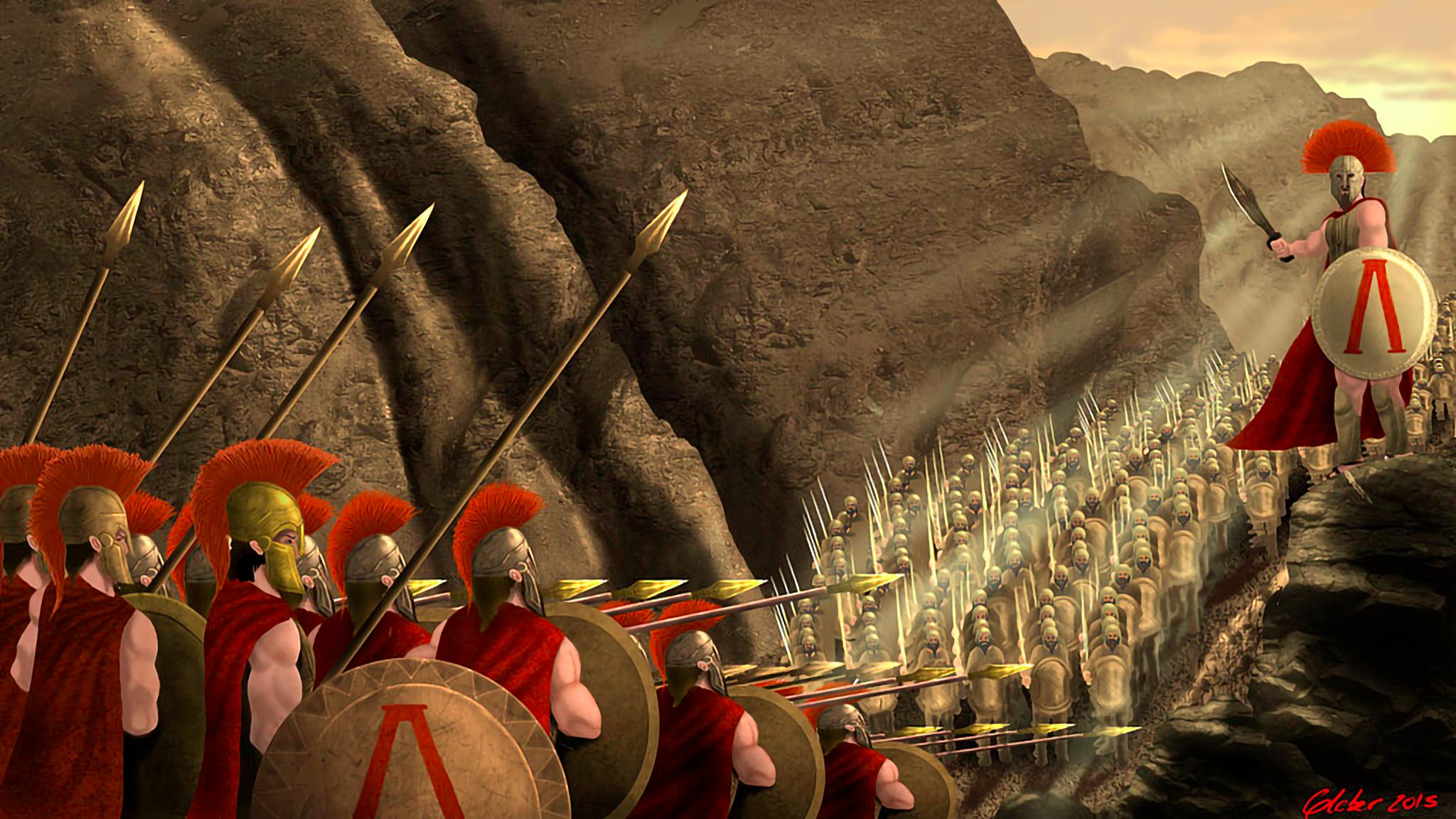Since the dawn of civilization there have been many brave and courageous people who conquered their fears and lived incredible lives. Courage or bravery isn’t the absence of fear but rather the triumph over it. But what if there is no fear? What would happen if we do not triumph over our fears but eradicate them completely from our minds and hearts?
This is a story of men who felt no fear. This is a story of 300 Spartans who were fearless, dauntless in face of their enemy. Their story will forever be told because never in the history of warfare did men face such odds and refused to be afraid. According to many the legend is more of a fantasy than history because it is unbelievable but the legend is true. At a place called Thermopylae in ancient Greece 300 intrepid Spartans stood against 100,000 Persians. With their unshakable resolve the mere force of 300 struck the Persian invaders with fear.
Sparta is a city in Laconia, on the Peloponnese in Greece. In ancient Greece it was a powerful city-state known for its militaristic traditions. At that time it was common for Greek city-states to fight amongst each other. Sparta reached the height of its power in 404 B.C. after its victory against Athens in the second Peloponnesian war.
Spartans studied war. From the very first day they were born, all Spartan men were trained to become warriors. Spartan infants were brought before a council of inspectors and examined for physical defects. Those babies who passed inspection didn’t have it easy. They were frequently ignored when they cried and commanded never to fear darkness or solitude.
At the age of 7, Spartan boys were removed from their homes and began the “Agoge,” a state-sponsored training regimen designed to mold them into skilled warriors and moral citizens. Separated from their families, the boys lived in barracks and were often beaten to make them tough. They were given little to eat in order to get used to what life would be like when they went to war. The boys were encouraged to fight one another.
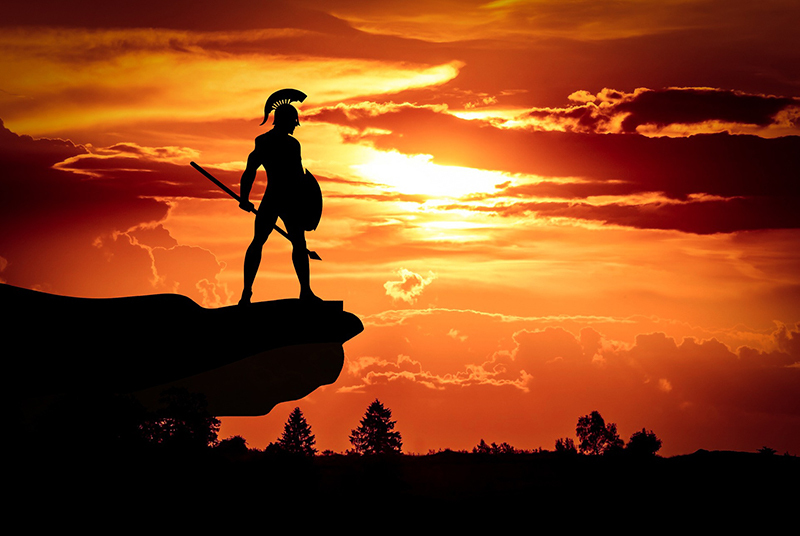
Teenagers had to survive the wild until the age of 20 to become member of Spartan military.
At age 12, initiates were deprived of all clothing save for a red cloak and forced to sleep outside and make their own beds from reeds. To ready them for a life in the field, the boy soldiers were also encouraged to scavenge and even steal their food, though if detected they were punished with floggings.
The Spartans trained rigorously and progressed through this training system until the age of 20 when they were allowed to join a communal mess and hence become a full citizen of the community. Each member of the mess was expected to provide a certain amount of foodstuffs and to keep training rigorously.
Girls, while not trained militarily, were expected to train physically. “Physical fitness was considered to be as important for females as it was for males, and girls took part in races and trials of strength,” writes Sue Blundell in her book “Women in Ancient Greece”.
Spartan girls were allowed to remain with their parents, but they were subjected to a rigorous education and training program. While boys were readied for a life on campaign, girls practiced dance, gymnastics and javelin throwing, which were thought to make them physically strong for motherhood. They also learned how to manage horses and they drove carriages in processions. The women of Sparta had more freedom and education than most Greek city-states at the time. Girls usually were married at the age of 18.
Spartan soldiers were expected to fight without fear and to the last man. Surrender was viewed as the epitome of cowardice, and warriors who voluntarily laid down their arms were so shamed that they often resorted to suicide. Training in pairs and in groups emphasized the bond and trust with their brothers in battle. Furthermore, the entire group was held accountable for the errors or underperformance of any single person in their team to emphasize interdependence. And there was a reason for that.
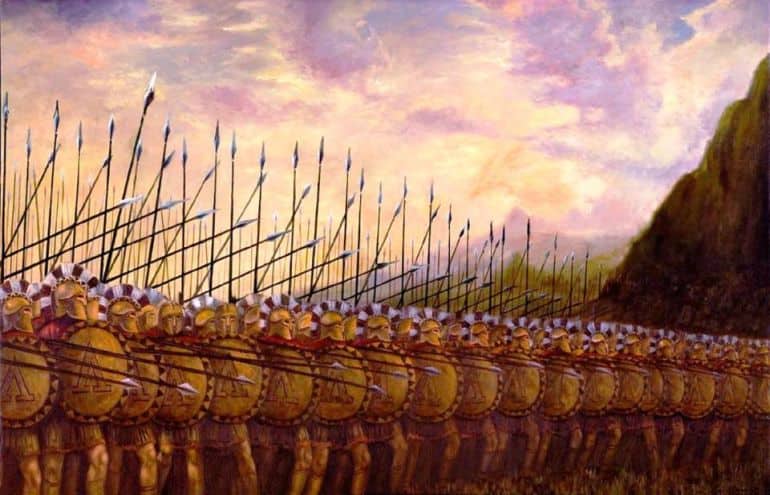
An artwork showing Spartans in their ‘Phalanx’ formation.
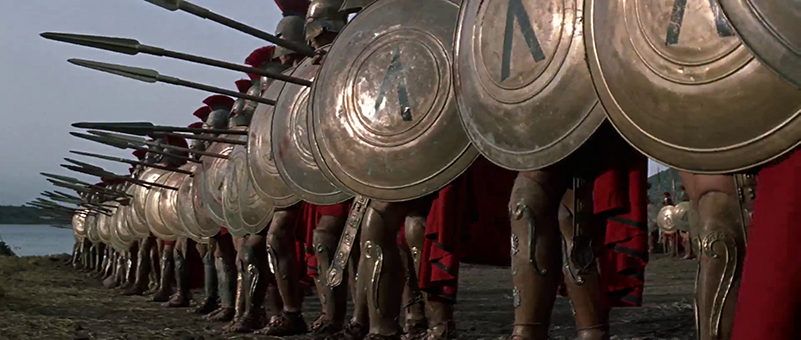
Scene from movie ‘The 300 Spartans’.
A Spartan soldier could lose his helmet or spear without worry but if he lost his shield he was punished beyond all means. It was because his helmet or spear were only needed for protecting himself but his shield was dearly important to his comrades. Spartan foot soldiers held their shields in a way that defended half of oneself and half of the soldier to his left at the battlefront, creating a continuous wall of shields.
If this wall broke, the whole army was doomed and not surprisingly, “dropping the shield” became synonymous with treachery in Sparta. Even the mother’s farewell to her son before he went into battle included a severe message, that her son had to return either “carrying the shield” (victorious) or “on the shield” (dead). Personal superiority, strength and bravery were valued only as far as it didn’t jeopardize the coherence of the team. They fought and died as one, to the very last man.
From 492 BC to 449 BC, the Spartans led the Greek city-states in a war against the Persians. It was during the Persian Wars that the Spartans fought the famous battle of Thermopylae where 300 Spartans held off hundreds of thousands of Persians.
Sparta was ruled by two kings who had equal power. There was also a council of five men called the ‘Ephors’ who watched over the kings. Laws were made by a council of 30 elders which included the two kings. When the Persian King Xerxes threatened Sparta, one of Sparta’s kings, Leonidas, became head of an anti-Persian coalition that ultimately made an ill-fated stand at Thermopylae.
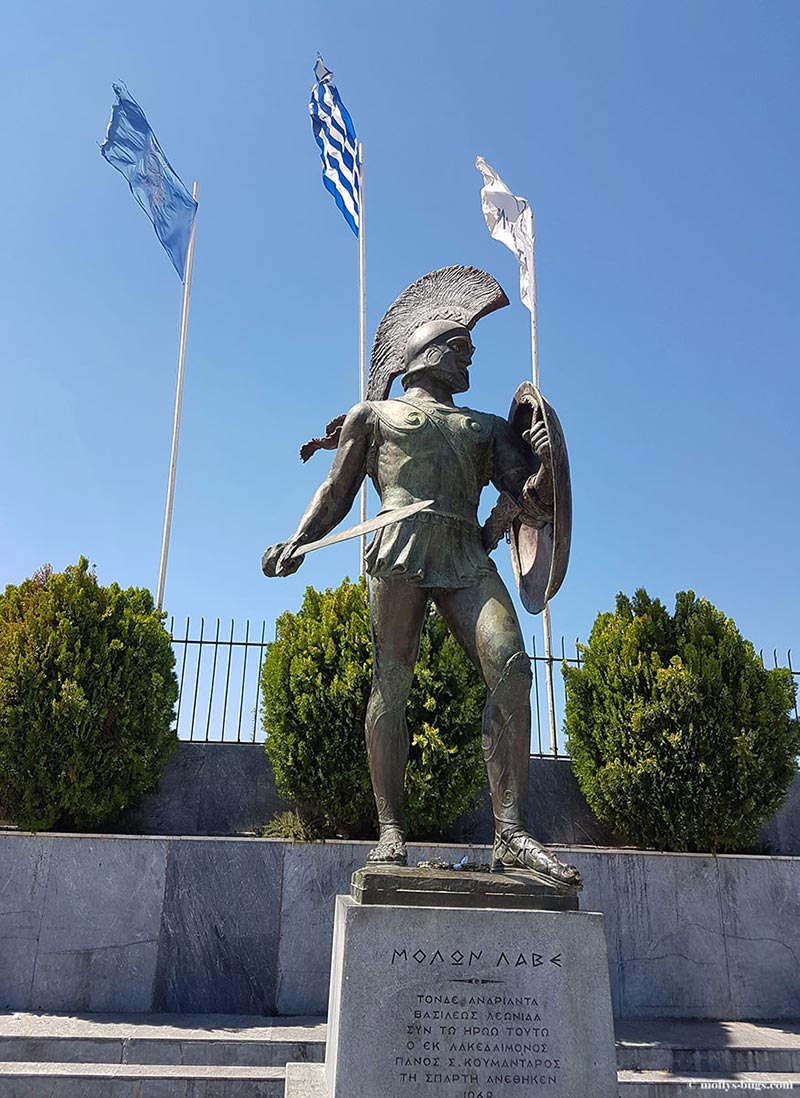
Statue of King Leonidas in a football ground at Sparta, Greece.
The pass of Thermopylae, located 150 km north of Athens was an excellent choice for defense with steep mountains running down into the sea leaving only a narrow marshy area along the coast. It was here, in a 15 metre wide gap with a sheer cliff protecting their left flank and the sea on their right side that the Greeks chose to make a stand against the invading army.
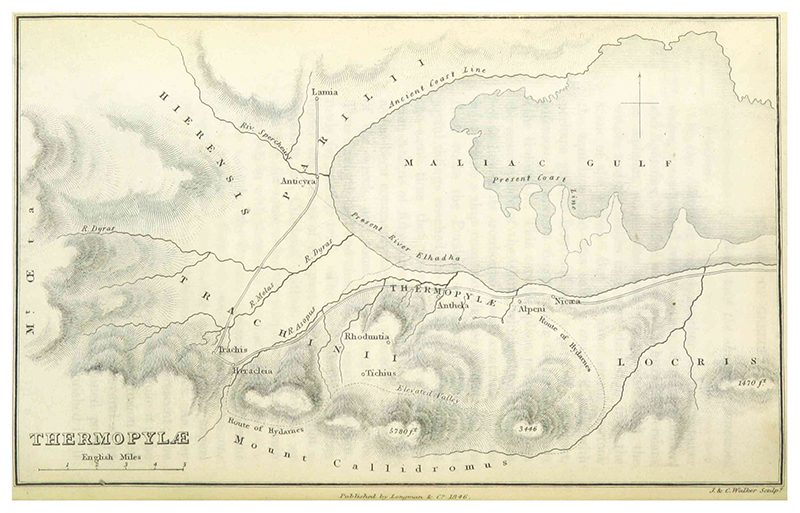
Map of Thermopylae
The Greek forces included 300 Spartans with 2,120 Arcadians, 1,000 Lokrians, 1,000 Phokians, 700 Thespians, 400 Corinthians, 400 Thebans, 200 men from Phleious, and 80 Mycenaeans. The relatively small size of the defending force has been explained as a reluctance by some Greek city-states to commit troops so far north, and due to religious motives, for it was the period of the sacred games at Olympia and the most important Spartan religious festival, the Karneia, and no fighting was permitted during these events.
They say that the barbarian has come near. Then we also are near to them.
Having somewhere in the region of 80,000-100,000 troops at his disposal, the Persian king, who led the invasion in person, first waited four days in expectation that the Greeks would flee in panic. The Persian infantry carried a lightweight (often crescent-shaped) wicker shield and were armed with a long dagger or battleaxe, a short spear, and composite bow. The Persian forces also included the Immortals, an elite force of 10,000 who were probably better protected with armour and armed with spears. The Persian cavalry were armed as the foot soldiers, with a bow and an additional two javelins for throwing and thrusting.
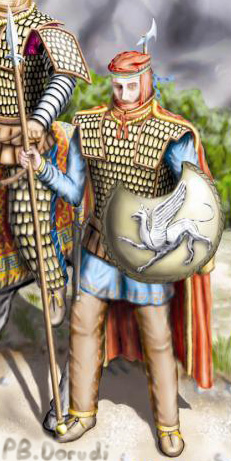
Artwork showing an armed Immortal.
When the Greeks held their position, Xerxes sent envoys to offer the defenders a last chance to surrender without bloodshed if the Greeks would only lay down their arms. The response of Leonidas to Xerxes was ‘molōn labe’ or ‘come and get them’ and so battle commenced. The two opposing armies were essentially representative of the two approaches to Classical warfare - the Persians favoured long-range assault using archers followed up with a cavalry charge, whilst the Greeks favoured heavily-armoured hoplites, arranged in a densely packed formation called the phalanx, with each man carrying a heavy round bronze shield and fighting at close quarters using spears and swords.
It is no hidden secret that the sheer level of training and high morale of the Spartans allowed them to be steadfast in the face of an overwhelming Persian force in the first day of the Battle of Thermopylae. The encounter didn’t prove to be successful for Xerxes, with the heavy defeat rather exacerbated by the constricted landscape of the pass. The Greek tactic of feigning a disorganised retreat and then turning on the enemy in the phalanx formation also worked well, lessening the threat from Persian arrows and perhaps the hoplites surprised the Persians with their disciplined mobility, a benefit of being a professionally trained army.
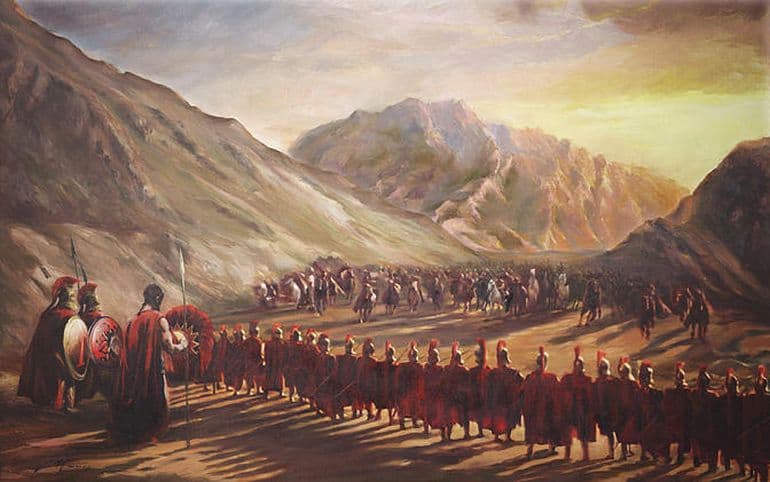
An artwork showing Spartans blocking an attack from Persian cavalry at Thermopylae.
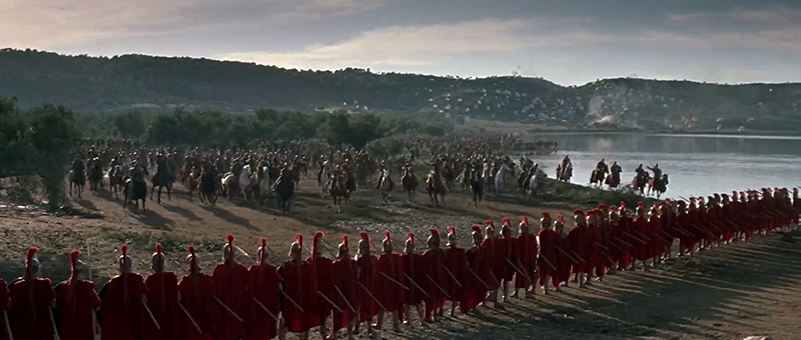
Scene from movie ‘The 300 Spartans’.
The second day followed the pattern of the first, and the Greek forces still held the pass. However, an unscrupulous traitor was about to tip the balance in favour of the invaders. Ephialtes, son of Eurydemos, a local shepherd from Trachis, seeking reward from Xerxes, informed the Persians of an alternative route --the Anopaia path-- which would allow them to avoid the majority of the Greek forces and attack their southern flank.
Leonidas had stationed the contingent of Phokian troops to guard this vital point but they, thinking themselves the primary target of this new development, withdrew to a higher defensive position when the Immortals attacked. This suited the Persians as they could now continue unimpeded along the mountain path and arrive behind the main Greek force. With their position now seemingly hopeless, and before their retreat was cut off completely, the bulk of the Greek forces were ordered to withdraw by Leonidas.
The Spartan king, on the third day of the battle, rallied his small force - the survivors from the original 300 Spartans, 700 Thespians and 400 Thebans - and made a rearguard stand to defend the pass to the last man in the hope of delaying the Persians progress, in order to allow the rest of the Greek force to retreat or also possibly to await relief from a larger Greek force.
If you men think that I rely on numbers, then all Greece is not sufficient, for it is but a small fraction of their numbers; but if on men's valor, then this number will do.
Instead of occupying the narrow pass, Leonidas ordered his assembled rear-guard to advance to a broader area, knowing well that their previously guarded position was now vulnerable to the approaching Immortals from behind. Interestingly enough, the orthodox method of marching was soon done with, as Persian arrows began to fall among the ranks. Leonidas, comprehending the urgency of the situation, ordered his men to sprint along the last few yards and quickly close the gap between the enemy and themselves.
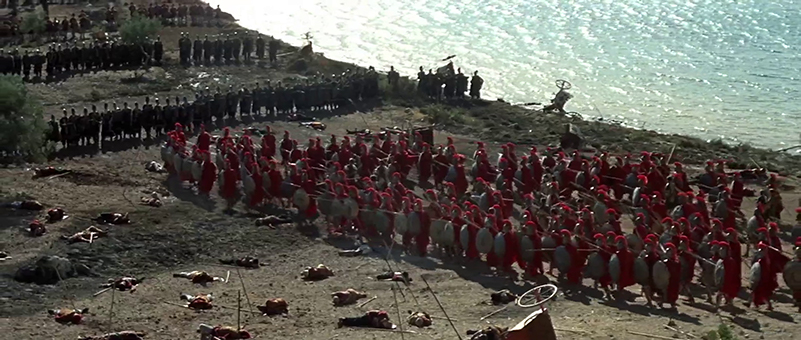
Scene from movie ‘The 300 Spartans’.
Once the armies met, a furious clash ensued, which resulted in even greater Persian casualties. But unfortunately for the Greeks, Leonidas met his demise in the chaotic melee engagement, and his guards valiantly defended the fallen body of their king to the last man. Thus ended the Battle of Thermopylae.
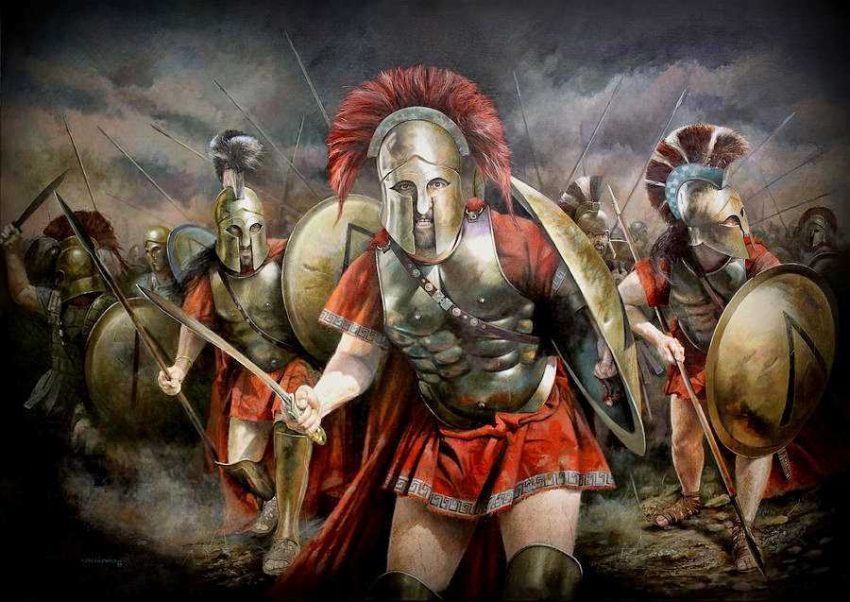
Artwork showing King Leonidas in his last moments.
Being asked why the best of men prefer a glorious death to an inglorious life, Leonidas said:
Because they believe the one to be Nature's gift but the other to be within their own control.
This battle stirred the Greek world into action. It sent a message to all the Greeks of what a few brave men can accomplish once they refuse to submit to tyranny. All the Greek states joined together to fight the Persians. The invasion was brought to an end the following year after the Greek victory at the Battle of Plataea.
